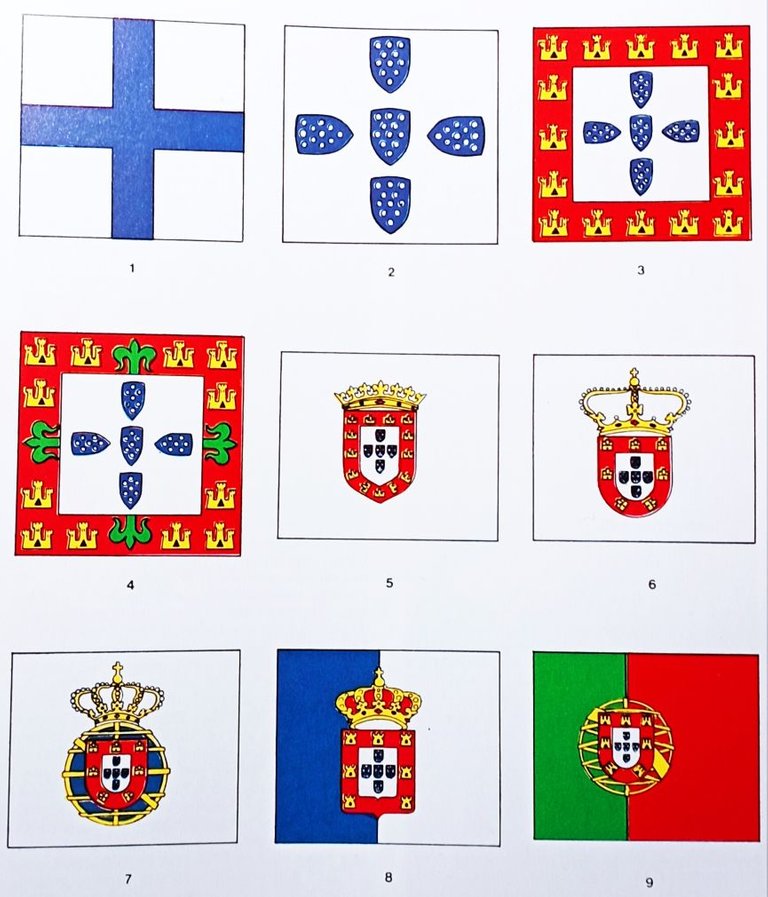
Hello, hivers!
Lately, I have been thinking about how for decades History of our people has gotten lost for many reasons, environmental catastrophes, accidents, deterioration, and so on.
I mean, how much ancient knowledge have we lost just when the Library of Alexandria burned down? Inquisition, floods, tornados, well you got the idea.
As I've been submerged in some Portuguese history books, I realized that maybe I could bring some of our story to the Hive blockchain and make it eternal.
For such a small country, we were quite powerful, with great people and remarkable deeds that I find very interesting and I would like to share with you...
I'm still deciding if I'm going present personalities as they come up, but surely from the beginning.
But for the first one, I want to talk about the Portuguese flag.
Because what's the most representative symbol of a nation than its flag? And for us Portuguese, there were many symbolic flags, mostly marking a change in our history.
It's hard to be 100% accurate about the flag's history due to its long history but this information is what we learn.
In any case, the use of the royal weapons as a national symbol dates back to D. Afonso Henriques (1143-1185, first king of Portugal): history says that in his first battles he used a white shield with a blue cross (symbolizing the royal weapons), from which our first flag was born.
Later, in 1185, when King D. Sancho I changed the royal weapons design, we no longer had a blue cross, but five blue shields arranged in a cross.
In 1248, with King D. Afonso III, a red border with golden castles was added. The castles were a representation of the origin of D. Afonso III, Reino de Castela.
The second dynasty begins with D. João I in 1385, who also decided to put his stamp on the flag, redesigning the castles and adding the tips of the green flowered cross of the Ordem de Avis. During his reign, we see for the first time the blue shields called "quinas".
D. João II (1481-1495) eliminated the cross of the Order of Avis and rearranged the shields so all would be in the same direction.
His successor, D. Manuel I, transformed the flag into a shield over a white flag and placed a crown on the shield as a symbol of the monarchy.
D. Sebastião I (1557-1578) was the youngest Portuguese king, proclaimed king at the age of 3 in 1557. Before leaving for Africa, D. Sebastião ordered the royal crown to be closed over the shield. In the Middle Ages, the royal flag was held by the alferes-mor, who preceded the monarch when he commanded his troops in battle.
The fabric of the royal flag consisted of various materials: satin, taffeta, rouge, damask, and different qualities of silk. The dimensions also varied greatly, as did the shape - either square or rectangular.
In the reign of D. João VI (1816-1826), a golden armillary sphere was placed behind the shield on a blue field, and on top was a closed royal crown - this flag was a representative symbol of the United Kingdom of Portugal, Brazil and the Algarves.
With the declaration of independence of Brazil in 1822 and the recognition by Portugal in 1825, the dream of the United Kingdom of Portugal, Brazil, and the Algarves ended.
It became necessary to change the symbols. On October 18, 1830, a decree by D. Pedro IV established that the national flag would be divided vertically into white and blue, with the blue placed next to the mast and the royal weapons in the center, resting half on each of the colors.
After the proclamation of the Republic, a commission (composed of Columbano Bordalo Pinheiro, João Chagas, and Abel Botelho, among others) was appointed to propose a new flag project, which was approved by the Provisional Government and the Assembly.
By decree of July 19, 1911, the characteristics of our flag were established: It was to be vertically divided and have two main colors: Dark green and red. The national coat of arms is located on the dividing line between the two-color zones. The shield (red and white) is based on an armillary sphere (yellow with a black border).
Since 1911, the Portuguese flag has remained untouched.

1. 1143 - 1185
2. 1185 - 1248
3. 1248 - 1385
4. 1385 - 1481
5. 1495 - 1578
6. 1578 - 1816
7. 1816-1830
8. 1830 - 1910
9. 1910 - until today.
Does your flag have a nice story?
oh my you actually wrote something on this board! that now makes me obliged to do my share :D
Congratulations @fromdrab2fab! You have completed the following achievement on the Hive blockchain and have been rewarded with new badge(s):
Your next target is to reach 8000 upvotes.
You can view your badges on your board and compare yourself to others in the Ranking
If you no longer want to receive notifications, reply to this comment with the word
STOPSupport the HiveBuzz project. Vote for our proposal!
The Hivebuzz proposal already got important support from the community. However, it lost its funding a few days ago and only needs a few more HP to get funded again.
May we ask you to support it so our team can continue its work this year?
You can do it on Peakd, ecency, or using HiveSigner.
Your support would be really helpful and you could make a difference.
Thank you!Dear @fromdrab2fab, we need your help!